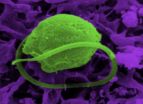(Press-News.org) A simple formula can predict at birth a baby's likelihood of becoming obese in childhood, according to a study published today in the open access journal PLOS ONE.
The formula, which is available as an online calculator, estimates the child's obesity risk based on its birth weight, the body mass index of the parents, the number of people in the household, the mother's professional status and whether she smoked during pregnancy.
The researchers behind the study hope their prediction method will be used to identify infants at high risk and help families take steps to prevent their children from putting on too much weight.
Childhood obesity is a leading cause of early type 2 diabetes and heart and circulatory disease, and is becoming more common in developed countries. According to NHS figures, 17 per cent of boys and 15 per cent of girls aged two to 15 in England are classified as obese.
The researchers developed the formula using data from a study set up in 1986 following 4000 children born in Finland. They initially investigated whether obesity risk could be assessed using genetic profiles, but the test they developed based on common genetic variations failed to make accurate predictions. Instead, they discovered that non-genetic information readily available at the time of birth was enough to predict which children would become obese. The formula proved accurate not just in the Finnish cohort, but in further tests using data from studies in Italy and the US.
"This test takes very little time, it doesn't require any lab tests and it doesn't cost anything," said Professor Philippe Froguel, from the School of Public Health at Imperial College London, who led the study.
"All the data we use are well-known risk factors for childhood obesity, but this is the first time they have been used together to predict from the time of birth the likelihood of a child becoming obese."
The 20 per cent of children predicted to have the highest risk at birth make up 80 per cent of obese children. The researchers suggest that services such as dieticians and psychologists could be offered to families with high-risk infants to help them prevent excessive weight gain.
"Once a young child becomes obese, it's difficult for them to lose weight, so prevention is the best strategy, and it has to begin as early as possible," said Professor Froguel. "Unfortunately, public prevention campaigns have been rather ineffective at preventing obesity in school-age children. Teaching parents about the dangers of over-feeding and bad nutritional habits at a young age would be much more effective."
Although common genetic variants did not prove to be helpful for predicting childhood obesity, the researchers say about one in 10 cases of obesity are caused by rare mutations that seriously affect appetite regulation. Tests for these mutations could become available to doctors in the next few years as the cost of DNA sequencing technology falls.
###
The Imperial researchers conducted the study in collaboration with colleagues at the University of Oulu, Finland; Harvard University in the US and the University of Verona, Italy. The work was funded by the Medical Research Council, Imperial College London, the University of Oulu and Centre National de la Recherche Scientifique.
The obesity risk calculator is available online at http://files-good.ibl.fr/childhood-obesity/
For further information please contact: Sam Wong
Out of hours duty press officer: 44-7803-886-248
Notes to editors
1. Reference: A Morandi et al. 'Estimation of newborn risk for child or adolescent obesity: lessons from longitudinal birth cohorts' PLOS ONE 28 November 2012.
After embargo link: http://dx.plos.org/10.1371/journal.pone.0049919
2. About Imperial College London
Consistently rated amongst the world's best universities, Imperial College London is a science-based institution with a reputation for excellence in teaching and research that attracts 14,000 students and 6,000 staff of the highest international quality. Innovative research at the College explores the interface between science, medicine, engineering and business, delivering practical solutions that improve quality of life and the environment - underpinned by a dynamic enterprise culture.
Since its foundation in 1907, Imperial's contributions to society have included the discovery of penicillin, the development of holography and the foundations of fibre optics. This commitment to the application of research for the benefit of all continues today, with current focuses including interdisciplinary collaborations to improve global health, tackle climate change, develop sustainable sources of energy and address security challenges.
In 2007, Imperial College London and Imperial College Healthcare NHS Trust formed the UK's first Academic Health Science Centre. This unique partnership aims to improve the quality of life of patients and populations by taking new discoveries and translating them into new therapies as quickly as possible.
Website: www.imperial.ac.uk
3. For almost 100 years the Medical Research Council has improved the health of people in the UK and around the world by supporting the highest quality science. The MRC invests in world-class scientists. It has produced 29 Nobel Prize winners and sustains a flourishing environment for internationally recognised research. The MRC focuses on making an impact and provides the financial muscle and scientific expertise behind medical breakthroughs, including one of the first antibiotics penicillin, the structure of DNA and the lethal link between smoking and cancer. Today MRC funded scientists tackle research into the major health challenges of the 21st century. www.mrc.ac.uk
Risk of childhood obesity can be predicted at birth
2012-11-29
ELSE PRESS RELEASES FROM THIS DATE:
Liverpool scientists decipher genetic code of wheat
2012-11-29
Scientists at the University of Liverpool have deciphered the genetic code of wheat to help crop breeders increase yield and produce varieties that are better suited to a changing environment.
Wheat is one of the world's most important food crops, accounting for 20% of the world's calorific intake. Global wheat production, however, is under threat from climate change and an increase in demand from a growing human population.
The Liverpool team, at the University's Centre for Genomic Research, used new methods of sequencing DNA to decode the large wheat genome, ...
Testicular cancer risk tripled in boys whose testes fail to descend
2012-11-29
Boys whose testes have not descended at birth—a condition known as cryptorchidism—are almost three times as likely to develop testicular cancer in later life, finds an analysis of the available evidence published online in Archives of Disease in Childhood.
The findings prompt the authors to ask whether boys with the condition should be regularly monitored to lessen the potential risk
Cryptorchidsim, where testes fail to descend into the scrotum and are retained within the abdomen, is the most common birth defect in boys, affecting around 6% of newborns.
The authors ...
Texas astronomers measure most massive, most unusual black hole using Hobby-Eberly Telescope
2012-11-29
Fort Davis, Texas — Astronomers have used the Hobby-Eberly Telescope at The University of Texas at Austin's McDonald Observatory to measure the mass of what may be the most massive black hole yet — 17 billion Suns — in galaxy NGC 1277. The unusual black hole makes up 14 percent of its galaxy's mass, rather than the usual 0.1 percent. This galaxy and several more in the same study could change theories of how black holes and galaxies form and evolve. The work will appear in the journal Nature on Nov. 29.
NGC 1277 lies 220 million light-years away in the constellation Perseus. ...
Ponatinib acts against the most resistant types of chronic myeloid leukemia
2012-11-29
HOUSTON – A previously invincible mutation in chronic myeloid leukemia (CML) has been thwarted by an investigational drug in a phase I clinical trial reported in the current edition of The New England Journal of Medicine.
All 12 patients in the trial with chronic phase CML and the T315I mutation had a complete hematologic response (absence of CML cells in the blood) after treatment with ponatinib. Eleven had a major reduction in CML cells in the bone marrow and nine achieved a complete cytogenetic response – no cells in the marrow.
T315I is present in up to 20 percent ...
In Cedars-Sinai study, common drug reverses common effect of Becker muscular dystrophy
2012-11-29
LOS ANGELES (Nov. 28, 2012) – Cedars-Sinai Heart Institute researchers have found in an initial clinical trial that a drug typically prescribed for erectile dysfunction or pulmonary hypertension restores blood flow to oxygen-starved muscles in patients with a type of muscular dystrophy that affects males, typically starting in childhood or adolescence.
Tadalafil, commonly known by brand names Cialis and Adcirca, reversed the effects of a biochemical chain of events that in Becker muscular dystrophy deprives muscles of an important chemical, nitric oxide, which normally ...
New practices reduce surgical site infections after colorectal surgery
2012-11-29
LOS ANGELES — EMBARGOED UNTIL 1 P.M. EST ON WEDS. NOV. 28, 2012 – Surgical teams at Cedars-Sinai have reduced surgical site infections by more than 60 percent for patients who undergo colorectal procedures by introducing evidence-based protocols that are easy to follow and relatively low in cost.
Surgeons, nurses, operating room staff and patients all collaborated in a quality improvement project that measured surgical site infection rates from March 2011 to March 2012. Several new steps were introduced to guard against infections, and these have now been expanded and ...
Algae held captive and genes stolen in crime of evolution
2012-11-29
Microscopic animals held algae captive and stole their genes for energy production, thereby evolving into a new and more powerful species many millions of years ago reveals a new study published today in the journal Nature.
The results reveal a 'missing link' in evolution because the tiny animal thieves (protozoa) couldn't completely hide all evidence of the captive algae, and have been effectively frozen in time and caught in the act by genetic sequencing.
The protozoa captured genes for photosynthesis- the process of harnessing light to produce energy which is used ...
Autumn sets in rapidly on Saturn's giant moon
2012-11-29
Thanks to NASA's Cassini spacecraft which has been orbiting Saturn since 2004, scientists have been able to observe for the first time ever the seasonal atmospheric circulation direction change on Titan – an event which only happens once every 15 years and is never observable from Earth. Their findings are published today in Nature.
Titan, while technically only a moon, is bigger than the planet Mercury, and is often considered a planet in its own right. It is the only known moon to have a significant atmosphere and is one of only four terrestrial atmospheres in our ...
Scientists develop new approach to support future climate projections
2012-11-29
Scientists have developed a new approach for evaluating past climate sensitivity data to help improve comparison with estimates of long-term climate projections developed by the Intergovernmental Panel on Climate Change (IPCC).
The sensitivity of global temperature to changes in the Earth's radiation balance (climate sensitivity) is a key factor for understanding past natural climate changes as well as potential future climate change.
Many palaeoclimate studies have measured natural climate changes to calculate climate sensitivity, but a lack of consistent methodologies ...
Health-care providers can play critical role in reducing and preventing intimate partner violence
2012-11-29
(Boston) – In a perspective article to appear in the Nov. 29 issue of the New England Journal of Medicine, researchers from Boston University Schools of Medicine and Public Health (BUSM and BUSPH) report that health-care providers can play a critical role in helping to reduce and prevent intimate partner violence (IPV) by screening and referring patients to appropriate resources.
The U.S. Centers for Disease Control and Prevention recently released a comprehensive report on the prevalence of sexual violence, stalking and IPV in the U.S. The report relays the alarming ...



